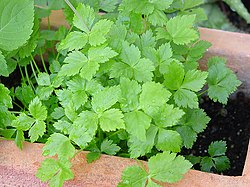| Cryptotaenia | |
|---|---|
 | |
| Cryptotaenia japonica | |
| Scientific classification | |
| Kingdom: | Plantae |
| Clade: | Tracheophytes |
| Clade: | Angiosperms |
| Clade: | Eudicots |
| Clade: | Asterids |
| Order: | Apiales |
| Family: | Apiaceae |
| Subfamily: | Apioideae |
| Tribe: | Oenantheae |
| Genus: | Cryptotaenia DC. |
| Type species | |
| Cryptotaenia canadensis | |
| Synonyms [1] | |
| |
Cryptotaenia, or honewort, [2] is a genus of herbaceous perennial plants, native to North America, Africa, and eastern Asia, growing wild in moist, shady places.